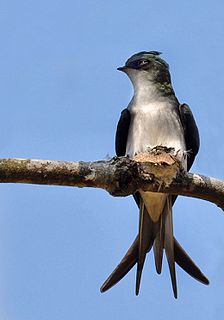 W
WThe African darter (Anhinga rufa), sometimes called the snakebird, is a water bird of sub-Saharan Africa and Iraq.
 W
WThe baglafecht weaver is a species of weaver bird from the family Ploceidae which is found in eastern and central Africa. There are several disjunct populations with distinguishable plumage patterns. Only some races display a discrete non-breeding plumage.
 W
WThe crested malimbe is a species of bird in the family Ploceidae. It is found in Angola, Cameroon, Central African Republic, Republic of the Congo, Democratic Republic of the Congo, Ivory Coast, Equatorial Guinea, Gabon, Ghana, Guinea, Liberia, Mali, Nigeria, Sierra Leone, Togo, and Uganda. Its natural habitat is subtropical or tropical moist lowland forests.
 W
WThe emperor goose, also known as the beach goose or the painted goose, is a waterfowl species in the family Anatidae, which contains the ducks, geese, and swans. It is blue-gray in color as an adult and grows to 66–71 centimetres (26–28 in) in length. Adults have a black chin and throat, a pink bill, yellow-orange legs, and a white head, which often turns reddish-brown in summer. In the winter, the emperor goose lives in mudflats and coasts in Alaska and occasionally Canada and the contiguous United States. In the summer, it migrates northerly several hundred miles to arctic and sub-arctic climates, where older individuals breed monogamously. Nests are constructed in holes and built up with vegetation and feathers. Eggs hatch in late June and early July, and goslings leave the nest the day they hatch. The species is an omnivore, and makes vocalizations that are more nasal than those of other geese. Listed as near threatened by the International Union for Conservation of Nature, the species' population is declining due to threats such as pollution, hunting, and climate change.
 W
WThe grey-rumped treeswift is a species of bird in the Hemiprocnidae family. There are currently four extant species in the family. Like the other members of Hemiprocnidae, this species is closely related to true swifts as well. However, unlike true swifts, the treeswifts are arboreal in nature, often seen perched on trees, high tension power transmission lines and on pylons. When perched, the wing tips cross over the tail. This species is commonly found in peninsular Malaysia but has an extremely large range with limited information about the population trend,.
 W
WThe speckle-fronted weaver is a species of bird in the family Ploceidae. It is found in Africa from Mauritania and Gambia in the west to Ethiopia and Tanzania in the east. Its natural habitat is dry savanna.
 W
WThe white-backed woodpecker is a Eurasian woodpecker belonging to the genus Dendrocopos.
 W
WThe white-naped honeyeater is a passerine bird of the honeyeater family Meliphagidae native to eastern Australia. Birds from southwestern Australia have been shown to be a distinct species, Gilbert's honeyeater, and the eastern birds are more closely related to the black-headed honeyeater of Tasmania. One of several similar species of black-headed honeyeaters in the genus Melithreptus, it dwells in dry sclerophyll eucalypt woodland. Its diet consists of nectar from various flowers, and it also feeds on insects.
 W
WThe white-tailed tropicbird (Phaethon lepturus) is a species of tropicbird. It is the smallest of three closely related seabirds of the tropical oceans and smallest member of the order Phaethontiformes. It is found in the tropical Atlantic, western Pacific and Indian Oceans. It also breeds on some Caribbean islands, and a few pairs have started nesting recently on Little Tobago, joining the red-billed tropicbird colony. In addition to the tropical Atlantic, it nests as far north as Bermuda, where it is locally called a "longtail".